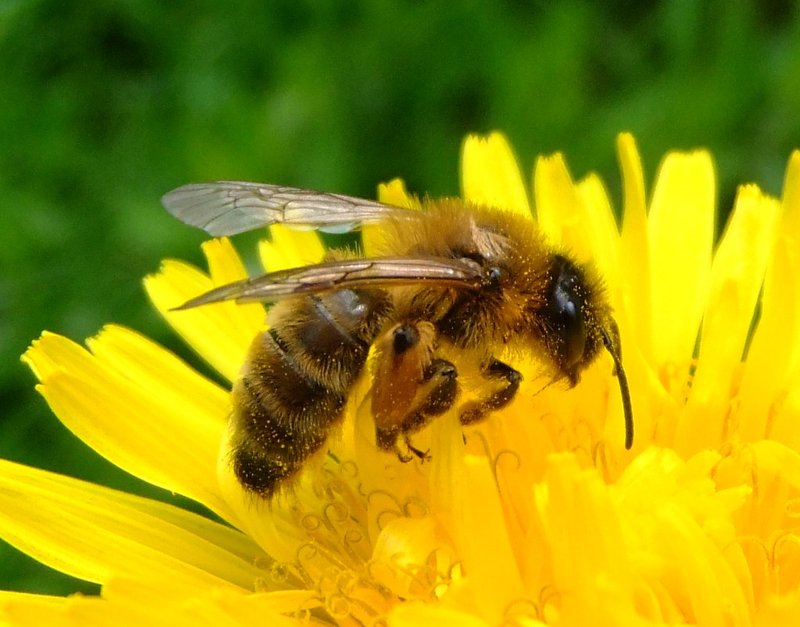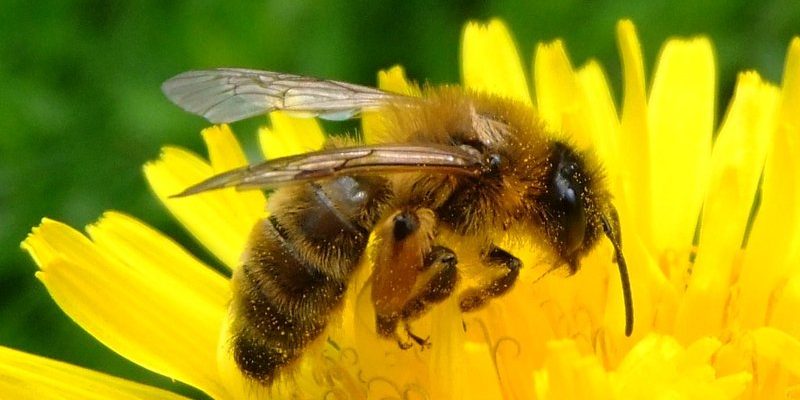
There’s a whole world of bees out there, each with its unique characteristics and importance. In this article, we’ll explore the top 10 most common bee species you might encounter, along with pictures to help you recognize them. We’ll dive into what makes each species special, their habitats, and a few fun facts. So, if you’ve ever found yourself wondering about the different kinds of bees buzzing around your garden, grab a comfy seat and let’s get into it!
1. Honey Bee (Apis mellifera)
When you think of bees, the honey bee probably springs to mind first. These little workhorses are famous for the sweet nectar they turn into honey. Honey bees live in large colonies and can number in the thousands. They have a strong sense of community, working tirelessly to gather nectar and pollen from flowers.
What’s fascinating about honey bees is their communication style. They perform a “waggle dance” to inform other bees about the locations of food sources! If you’ve ever seen bees buzzing around a flower bed, chances are they’re doing exactly that.
Habitat: Honey bees thrive in a variety of environments, from gardens to orchards, and they’re often managed by beekeepers who keep them for honey production.
2. Bumblebee (Bombus spp.)
Bumblebees are like the fluffy teddy bears of the bee world. Larger and fuzzier than honey bees, these social insects are known for their loud buzz and ability to pollinate plants even in cooler temperatures. They’re remarkable for their “buzz pollination” technique, which allows them to shake pollen loose from flowers by vibrating their bodies.
One interesting thing about bumblebees is that they can be found in a wider range of habitats, including gardens, grasslands, and forests. Their colonies are much smaller than those of honey bees, usually comprising 50 to 400 bees per nest.
Habitat: You can find bumblebees in gardens, meadows, and even urban areas, often nesting in soft ground or abandoned rodent holes.
3. Carpenter Bee (Xylocopa spp.)
Carpenter bees are often mistaken for bumblebees due to their similar sizes and colors. But instead of fuzzy bodies, carpenter bees have shiny, hairless abdomens. These bees get their name from their unique nesting habits—they bore into wood to create their homes.
While they may seem a bit destructive, they play an important role in pollination too. Carpenter bees have long tongues, allowing them to reach deep into tubular flowers, which is great for certain types of plants.
Habitat: You’ll typically find carpenter bees in softwoods like cedar, pine, and fir. They prefer sunny spots to do their woodworking, often near decks and fences.
4. Mason Bee (Osmia spp.)
Mason bees are small, solitary bees that are amazing pollinators. Unlike honey bees that live in large colonies, mason bees prefer to go solo. They often lay their eggs in small cavities, using mud to seal off the nesting chambers—hence the name “mason.”
These bees are particularly important for early spring pollination, as they emerge before many flowers bloom. With their plump bodies and fuzzy faces, they’re effective at transferring pollen from flower to flower.
Habitat: Mason bees thrive in gardens with plenty of flowering plants and are often found nesting in hollow plant stems or wood holes.
5. Leafcutter Bee (Megachile spp.)
Leafcutter bees are fascinating because they use leaves to construct their nests. They cut small pieces from plants and carry them to their nests, which can be in the ground or in existing cavities. These bees are excellent pollinators for many crops, particularly alfalfa.
With their sleek bodies and unique nesting habits, leafcutter bees are truly remarkable. They are also solitary, like mason bees, and don’t produce honey. Instead, they create a little “nursery” for their eggs using the leaf pieces and pollen.
Habitat: Leafcutter bees can be found in gardens and agricultural fields, often near blooming plants that provide nesting materials.
6. Sweat Bee (Halictidae family)
Sweat bees are tiny, often metallic-looking bees that are attracted to the salt in human sweat. If you’ve ever been outside on a hot day and felt a tiny bee buzzing around you, you might have encountered a sweat bee! Despite their name, they’re actually excellent pollinators and come in many colors, from shiny green to dull black.
These bees can be solitary or social, depending on the species, and they’re particularly fond of wildflowers. They often nest in the ground, creating small burrows.
Habitat: Sweat bees thrive in various environments, including gardens, fields, and forests, where they can find plenty of flowers to pollinate.
7. Andrenid Bee (Andrena spp.)
Andrenid bees, also known as mining bees, are another group of solitary bees. They’re called mining bees because they typically dig tunnels in the ground to nest. These bees are often among the first to emerge in spring, making them valuable pollinators for early-blooming flowers.
While they may not produce honey, they play a vital role in our ecosystems. With their stocky bodies and varied colors, you might find them buzzing around your garden flowers.
Habitat: Andrenid bees favor sandy or loose soil for nesting and can be commonly found in meadows and gardens.
8. Alkali Bee (Nomia spp.)
Alkali bees are interesting creatures that prefer to live in alkaline soils. They’re solitary and have a unique nesting behavior, often digging burrows in the ground. These bees are particularly important for pollinating crops like alfalfa, as they are very efficient pollinators.
Although they might not be as well-known as honey bees, alkali bees are crucial for agriculture, especially in arid regions where they thrive.
Habitat: You can find alkali bees in places with alkaline soils, often near agricultural fields where they can find plenty of flowers to pollinate.
9. Robber Bee (Thryptocline spp.)
Robber bees are a group of kleptoparasitic bees, meaning they steal nectar and pollen from other bees’ nests instead of gathering their own. While this behavior might seem sneaky, they still contribute to pollination.
These bees have a unique appearance, often resembling honey bees, but they’re typically less social and have a different foraging strategy. Their resourcefulness allows them to thrive in various environments, from gardens to forests.
Habitat: Robber bees can be found in diverse areas, often close to other bee populations where they can “rob” resources.
10. Asian Honey Bee (Apis cerana)
The Asian honey bee is similar to the Western honey bee but has some notable differences. These bees are smaller and have a different social structure. They tend to be more resilient to diseases and pests, making them important for biodiversity.
Asian honey bees also play a key role in pollinating many crops, especially in Asia, where they’re kept for honey production. If you’ve ever tasted honey that has a unique flavor profile, it might have come from these industrious little creatures.
Habitat: Asian honey bees thrive in tropical and subtropical climates, often nesting in trees or under eaves in urban settings.
Bees are not just important for honey; they are vital for our planet’s health and the food we eat. Each bee species plays a unique role in pollination, ensuring that flowers bloom and fruits develop. Whether you’re planting a garden or simply enjoying time outdoors, keep an eye out for these remarkable creatures.
Understanding these common bee species can help us appreciate them more. So next time you see a bee buzzing by, remember: they’re not just after nectar—they’re also working hard to keep our ecosystem thriving. By protecting their habitats and supporting pollinator-friendly practices, we can ensure these buzzing buddies continue to flourish for generations to come.

